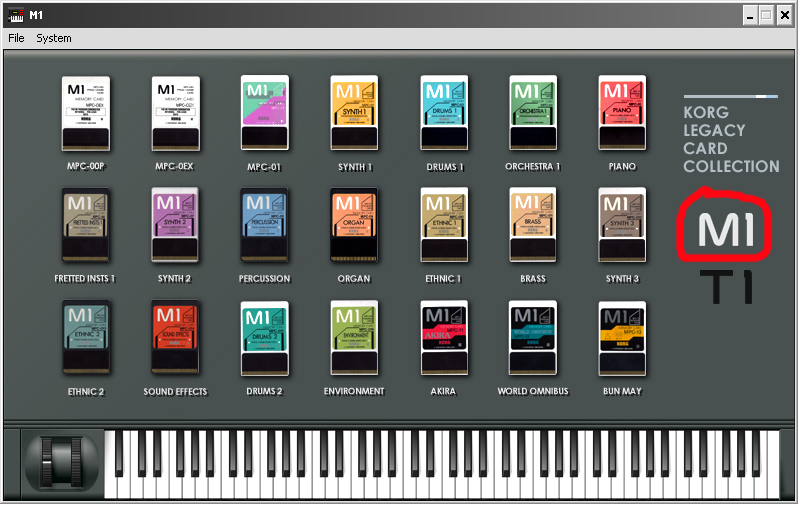Hi folks, The Korg M1 (hardware) does not seem to have it's own dedicated section on this site (it's an old synth I know and of course this is a more modern forum). All of the subject matters relating to Korg run right across the board (as one might expect of course). Anyway, rather than try and tag this onto a pre-existing discussion of old, or only partially related, I decided I would open a fresh topic here.
The Legacy Cell software synthesizer combines the sound of the Korg MS-20, Polysix and MDE-X in one dynamic performance unit. MS-20, Polysix and MDE-X. Released in 2004, the KORG Legacy Collection was a pioneer of software synthesizers. Now, we are proud to announce the release of the updated KORG Collection. Modulation settings and equipped Mono/Poly with virtual patch functionality. MicroKEY2; microKEY Air; nanoKEY Studio; nanoKONTROL Studio.
I did post on the official Korg forum a few weeks back but received zero response! Lol And I have gleaned a few small insights from other various forums but as yet, still no concrete answers. So, my first question being (please), are there any current M1 owners out there willing to help and discuss certain aspects about the programing and synthesis side of the machine? I did own an M1 in the early 90's for a couple of years or so, but at that point I was concentrating on other aspects of musicianship as opposed to being specifically into programing as such.
And then I sold my M1 when I went to music school. Recently, an M1 came up on eBay very cheap and located close by, but I narrowly missed out unfortunately. In any case, I am not especially interested in purchasing one (unless it came up very cheap again, as they sometimes do). There is of course the VST version which seems to be quite popular.
I may have purchased this as part of a VST (legacy) package had it have contained the Korg POLY 61. Days of our lives comings and goings. But this synth is absent (although the POLY 6 is in there) and so I have put such a purchase on the back burner for the time being. Many thanks in advance. Best, Paul David Seaman. Fender Rhodes Suitcase, Fender Rhodes Stage, Hohner E7 Clavinet, Mini Moog Model D, Multi Moog, Yamaha DX7 (Mk1) & DX21, Korg Poly 61, Roland Juno 6.
Mackie SRM 350 (pair), Fender DeVille, Yamaha HS7 (pair), BeyerDynamic DT880 Headphones, Pro (250 Ohm). Sibelius 7, Cubase Artist 8, HALion Sonic SE, HALion Sonic 2, HALion 5, Grand SE, Grand 3, Groove Agent 3, Arturia V_Collection, EZ2 Drummer, Steinberg CI2+ Interface, Lexicon MX300, Midi Sport 2x2.
Dell Inspiron 3737, Windows 10 Professional, 1.70gHz, 16GB RAM, 64-bit, Intel Core i3. The M1 doesn't really do a lot of synthesis. It relies mainly upon sampled waveforms, which are then subtractively processed and put through it's built in effects unit. It is a hardware ROMPler, pretty much. There were two ways to expand the system: one was a data card containing patches, while the other was a wave/sample card, which contained new waveforms, and possibly new patches which used these waveforms.
I am going mostly from memory here, and I loved my M1 when I owned it. I think I bought mine in 1989, which was it's second year, if I'm not mistaken. I also bought a Yamaha SY77 at the same time, which had true synthesis, and subtractive waveform processing, as well. The SY77 excelled at more organic sounds, especially strings and horns, while the M1 excelled in some other areas. The M1 drum kit was particularly good at the time for a built-in synth drum kit, and I used that on just about everything, although for my live rig, I used a Roland S-330 sampler. The M1 also had a very cool organ sound, 'Korgan', which I believe was a third party patch. I used that on several mixes.

Hi again, Now, this is something I hope I can explain clearly:- If you edit a patch in PROG (lets say the RELEASE TIME of FRETLESS BASS [009]), you would increase the ' R' parameter (using the ' A~H' keypad under the display) to (say) ' +10'. And you decide you are quite happy with this EDIT and wish to SAVE it.
Lets assume for now you simply OVERWRITE it (ie to the same location). Again, no problem.
Then a couple of gigs down the line you decide that in actual fact, there is too much RELEASE TIME applied to the FRETLESS BASS patch. The obviously thing to do would be to re-enter PROG mode, and re-adjust the RELEASE TIME again to suit your needs. In theory this is ok, but the problem (for me) is that:- When you visually look at the RELEASE TIME setting, it does not say (as I would have thought/hoped) ' +10', but defaults back to ZERO! Download free mcintosh mx151 manual. Ok, so most people, even after a few beers would remember that they increased the RELEASE TIME by ' +10', but what if you had altered several parameters?
And you wanted to re-set the patch to its DEFAULT and then start again from fresh. You would be totally screwed because all of the ' A~H' parameters will be showing ZEROS and there would be no way of knowing/remembering what you had initially adjusted! In which case, lets say you EDIT a few of the ' A~H' parameters and before you SAVE it, the screen will look something like:- Att=+10 / Dec=-2/ Sus=+6/ Rel=-9/ and so on.